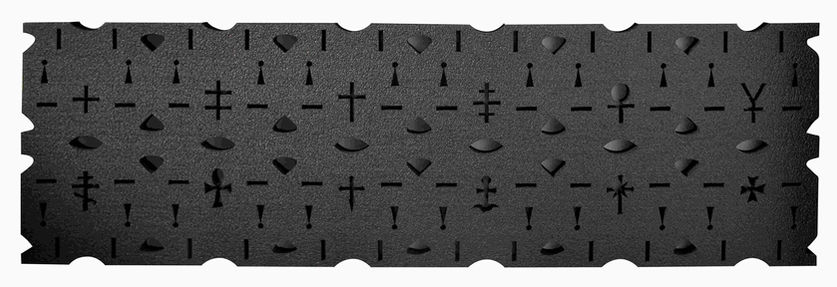Marie-France Veyrat
BLACK IV - Black is woe - 2024

Creus N1, 2013, poliestireno expandido tratado, 60x200x5,5cm.
The Black cycle has focused on black as the color, explored by different artists who use it regularly. The cycle has also allowed us to discuss light and the African continent through photographers who have produced various works with a non-colonialist perspective, including the work of an Afro-descendants who lives here and portrays our Africa, giving visibility to things and people we often do not see, both physically and conceptually. Black has also addressed the darker aspects of our society, which are numerous. Now, the cycle, coordinated by Calvet, reaches its end, talking about other endings, discussing pain and the end of life, but also the lights and hopes that are associated with them. We delve into a generic term like "affliction" (woe in English) to express deep sorrow, dejection, sadness, etc., and as a result, other aspects like faith, resilience, and many other concepts that are often opposed to the first ones. In Black is woe, we find ceremonies related to our present and future care, our sorrows and anxieties about the loss of loved ones, or the pains of ourselves and others that accompany us and become ours.
Àlvar Calvet




The cross has become a frequent theme in recent years in Veyrat's work, and here it becomes the main element of the semi-sculptural installation, which includes geometric objects, symbols, and signs, all related to the cross through the identification and relationship that various cultures have.


Black suggests a deep exploration of dark and emotional themes such as suffering, death, and mourning, which encapsulate an intense human experience. These themes reflect the human condition, allowing for a connection with these universal experiences. Through various forms of expression, I have been creating works that not only represent suffering and loss but also offer a way to process and understand these deep emotions.
The cross, the main element of the installation, evokes an universal, iconic, and historical symbol adopted by numerous cultures around the world. It is a recurring theme in Veyrat's work, which is part of a research project on the history of crosses, black crosses are integrated, expressing the three states within the semi-sculptural installation placed on the wall, reinforced by the arrangement of two individual elements. At the same time, the interaction between the notions of emptiness and fullness, of shadow and light, are frequent themes of my interest that play an important role in my work. I treat emptiness as if it were a material.
For this occasion, I want to highlight the cross as a symbol of suffering and horrors, but also as a sign of hope and resistance.